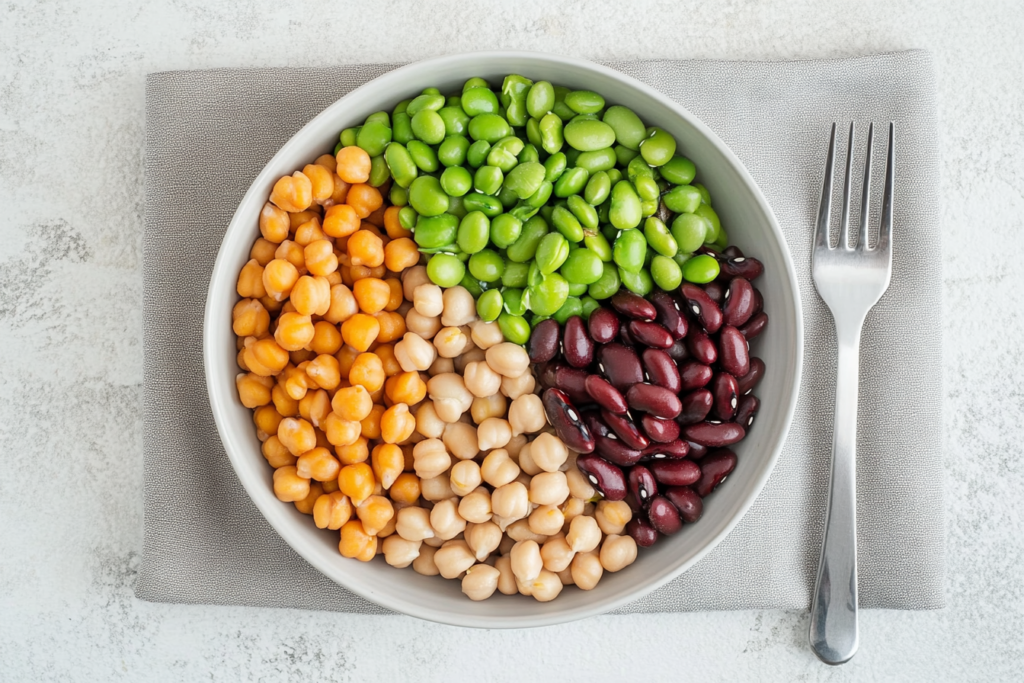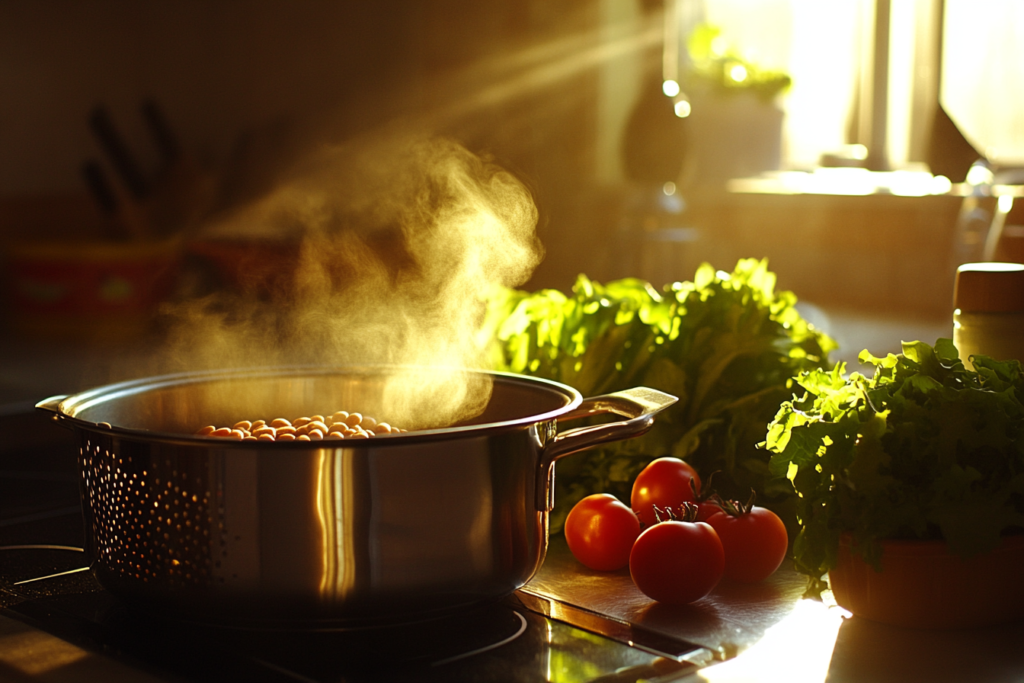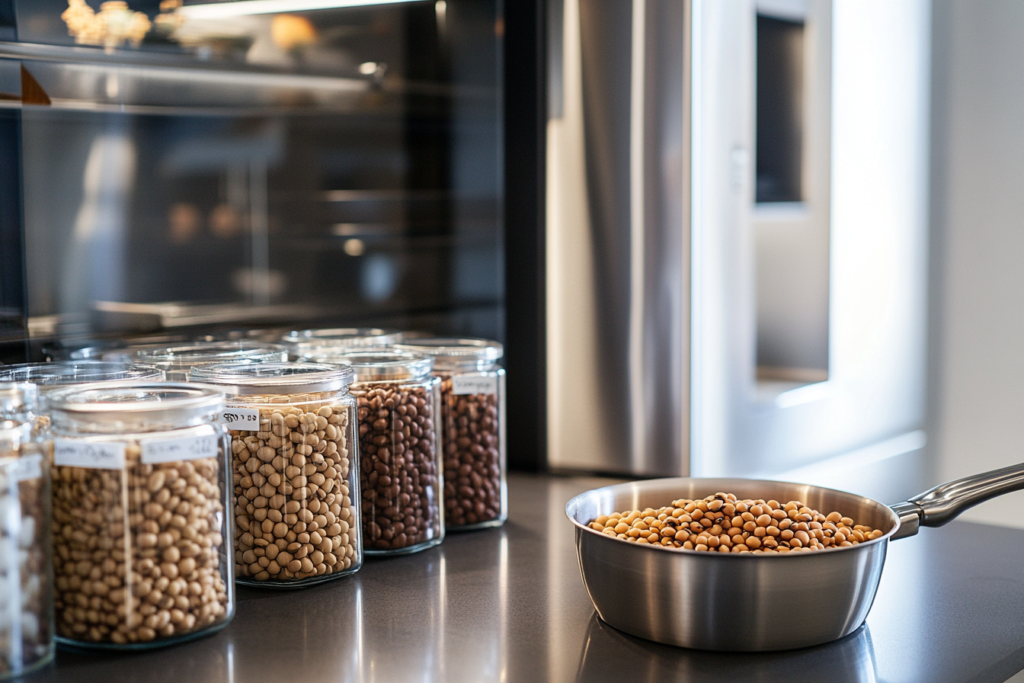Table of contents
Introduction to Salad Beans
Beans are a versatile and nutritious ingredient that has been a staple in diets across the globe for centuries. Whether enjoyed in hearty stews, savory dips, or refreshing salads, beans bring flavor, texture, and a wealth of health benefits to any dish. Among the most popular uses is in salads, where their natural creaminess and earthy flavors complement fresh vegetables, tangy dressings, and a variety of herbs and spices. What is the healthiest beans to put in a salad? This question often arises because selecting the right beans can significantly boost the nutritional value of your meal. Salad beans are not just a culinary delight but also a significant contributor to a balanced and health-conscious diet.
Why Beans are a Nutritional Powerhouse for Salads
Beans are often referred to as a “nutritional powerhouse,” and for good reason. Packed with essential nutrients, they offer a remarkable blend of health benefits:
- Rich in Protein: Beans are an excellent plant-based protein source, making them ideal for vegetarians and vegans. They provide the necessary building blocks for muscle repair and growth.
- High in Fiber: Their high fiber content supports digestive health, promotes satiety, and aids in maintaining healthy cholesterol levels.
- Low in Fat: Most beans are naturally low in fat, making them a heart-friendly option for those looking to reduce saturated fat intake.
- Abundant in Micronutrients: Beans are rich in essential vitamins and minerals, including folate, iron, potassium, and magnesium, which are critical for overall health and wellbeing.
- Low Glycemic Index: They release energy slowly, helping to maintain stable blood sugar levels, which is particularly beneficial for individuals with diabetes.
The Role of the Healthiest Beans in a Balanced Diet
Beans are a cornerstone of healthy eating patterns around the world. Incorporating them into your diet can lead to significant health improvements and prevent various chronic conditions:
- Heart Health: The fiber, potassium, and magnesium in beans contribute to improved heart health by regulating blood pressure and reducing cholesterol.
- Weight Management: Beans are low in calories but high in fiber and protein, keeping you full longer and helping to control hunger.
- Diabetes Management: Their low glycemic index ensures steady blood sugar levels, making them a smart choice for diabetes management and prevention.
- Sustainability: As a plant-based protein, beans are environmentally friendly and a sustainable alternative to animal proteins.
When asking what is the healthiest beans to put in a salad, the answer lies in their diversity and nutrition. Incorporating beans into salads is one of the simplest and most delicious ways to reap these benefits. From classic three-bean salads to innovative combinations with quinoa, avocado, or citrus fruits, the possibilities are endless. Beans bring depth, flavor, and nutrition to every plate, proving that healthy eating can be as enjoyable as it is beneficial.t healthy eating can be as enjoyable as it is beneficial.
Nutritional Benefits of Beans in Salads
Beans are a cornerstone of nutritious eating, offering a wide range of health benefits and essential nutrients that make them a valuable addition to any meal. When considering what is the healthiest beans to put in a salad, it’s important to note how beans enhance both the flavor and the nutritional profile of the dish, making them a smart choice for those seeking a balanced and wholesome diet.
Protein Content in the Healthiest Beans for Salads
One of the standout nutritional features of beans is their high protein content. This makes them an excellent plant-based protein source, particularly beneficial for vegetarians, vegans, or anyone looking to reduce their reliance on animal-based proteins.
- Essential Amino Acids: While beans are not a complete protein on their own, pairing them with grains like quinoa or rice in salads creates a complete amino acid profile.
- Muscle Repair and Growth: The protein in beans supports muscle maintenance and recovery, making bean salads an ideal post-workout meal.
- Satiety: Protein contributes to feeling full, reducing hunger and aiding in weight management.
Rich in Fiber for Digestive Health
Beans are celebrated for their impressive fiber content, which plays a critical role in maintaining digestive health and overall wellness.
- Promotes Regularity: Dietary fiber helps prevent constipation and promotes regular bowel movements.
- Gut Health: Fiber acts as a prebiotic, feeding beneficial gut bacteria and supporting a healthy microbiome.
- Cholesterol Management: Soluble fiber in beans binds with cholesterol in the digestive system, helping to lower LDL (bad) cholesterol levels.
- Weight Control: The fiber content in beans keeps you feeling full longer, helping to curb overeating.
Adding beans to salads not only boosts fiber intake but also pairs well with other high-fiber vegetables, enhancing the dish’s digestive benefits.
Vitamins and Minerals Found in the Best Salad Beans
Beans are a nutrient-dense food, packed with an array of essential vitamins and minerals that support various bodily functions.
- Folate: Crucial for DNA synthesis and cell division, folate is particularly important for pregnant individuals and those planning to conceive.
- Iron: Beans are a great plant-based source of iron, which is vital for oxygen transport in the blood and energy production.
- Potassium: This mineral helps regulate fluid balance, muscle contractions, and nerve signals, and it supports heart health.
- Magnesium: Magnesium contributes to energy production, muscle function, and bone health.
- Antioxidants: Many beans contain antioxidants, which combat free radicals and reduce oxidative stress.
Incorporating beans into salads ensures you’re getting a dose of these vital nutrients while enjoying a delicious and satisfying meal.
The Healthiest Beans to Use in Salads
Beans are a fantastic ingredient for salads, bringing flavor, texture, and a wealth of nutritional benefits. When determining what is the healthiest beans to put in a salad, some varieties stand out as particularly healthy and well-suited for salad recipes. Here’s a closer look at the healthiest beans to use in your salads.

Black Beans: A Heart-Healthy Salad Bean Choice
Black beans are a favorite in salads for their rich, earthy flavor and impressive nutritional profile.
- High in Fiber: They support heart health by helping to lower cholesterol levels.
- Rich in Antioxidants: Black beans contain anthocyanins, which help combat oxidative stress and inflammation.
- Versatile: Pair them with corn, avocado, and lime for a Southwestern-inspired salad, or mix them into grain bowls.
Chickpeas: A Versatile Nutritional Booster
Also known as garbanzo beans, chickpeas are a staple in many cuisines and a star ingredient in salads.
- Rich in Protein: Ideal for boosting protein content in plant-based meals.
- Loaded with Fiber: Supports digestion and promotes satiety.
- Versatile Flavor: Chickpeas adapt well to a variety of flavors, from Mediterranean to Indian-inspired salads.
Kidney Beans: Packed with Antioxidants
Kidney beans are not only visually appealing but also offer a robust nutritional profile.
- Antioxidant-Rich: Contain compounds like flavonoids that protect against cellular damage.
- High in Iron: A great choice for improving energy and supporting oxygen transport in the blood.
- Bold Texture: Their firm texture makes them a hearty addition to mixed vegetable salads or chili-inspired dishes.
Lentils: A Low-Calorie, High-Nutrient Option
Lentils are small but mighty, offering an array of health benefits in a low-calorie package.
- Low in Calories, High in Nutrients: Packed with protein, fiber, folate, and magnesium.
- Quick to Cook: Unlike some beans, lentils cook quickly, making them convenient for meal prep.
- Earthy Flavor: Combine with spinach, goat cheese, and balsamic vinaigrette for a sophisticated salad.
Edamame: The Protein-Rich Bean
Edamame, or young soybeans, are a powerhouse of plant-based protein and perfect for Asian-inspired salads.
- High in Protein: An excellent option for muscle repair and growth.
- Rich in Isoflavones: Compounds that may support heart health and hormonal balance.
- Crisp Texture: Their slight crunch pairs well with sesame dressing, carrots, and cabbage for a vibrant dish.
Cannellini Beans: A Mild and Creamy Favorite
Cannellini beans are a type of white bean known for their mild flavor and creamy texture.
- Mild Flavor: Their subtle taste allows them to blend seamlessly into a variety of salads.
- High in Fiber and Protein: Supports digestive health and provides a satisfying meal component.
- Perfect for Mediterranean Dishes: Combine with arugula, sun-dried tomatoes, and olives for a Mediterranean-inspired salad.
Preparing Beans for Your Salad
Beans are a versatile and nutritious ingredient, but proper preparation is key to ensuring they taste their best and retain their nutritional value. Whether you choose canned or dried beans, understanding their pros and cons, as well as cooking and storage techniques, will help you create flavorful and wholesome salads.

Canned vs. Dried Beans: Pros and Cons
Both canned and dried beans are excellent options, but they come with distinct advantages and considerations.
Canned Beans
- Pros:
- Convenience: Ready to use with no soaking or cooking required, making them a time-saver.
- Availability: Widely available and come in a variety of types.
- Consistent Texture: Soft and ideal for salads.
- Cons:
- Sodium Content: Often high in sodium, though rinsing them can reduce it by up to 40%.
- Cost: Generally more expensive than dried beans on a per-serving basis.
Dried Beans
- Pros:
- Cost-Effective: More affordable than canned beans, especially in bulk.
- Control Over Texture and Flavor: Cooking dried beans allows you to customize the softness and seasoning.
- Lower Sodium: Naturally low in sodium unless you add salt during cooking.
- Cons:
- Time-Consuming: Requires soaking (optional) and longer cooking times.
- Preparation Effort: Needs planning and effort for cooking and storing.
Tips for Cooking and Storing Beans
Cooking beans properly and storing them effectively ensures they remain fresh, flavorful, and ready for use in your salads.
Cooking Tips:
- Soaking Dried Beans:
- Overnight Soak: Soaking beans in water overnight reduces cooking time and improves digestibility by reducing compounds that can cause gas.
- Quick Soak: Boil beans for 2 minutes, then let them sit in hot water for 1 hour before cooking.
- Cooking:
- Use a large pot with plenty of water to allow beans to cook evenly.
- Add aromatics like garlic, onion, or bay leaves for flavor. Avoid adding salt until beans are tender, as salt can make the skins tough.
- Simmer gently to avoid breaking the beans.
- Check for Doneness:
- Beans should be tender but not mushy, perfect for salads.

Storing Beans:
- Refrigerating:
- Store cooked beans in an airtight container with their cooking liquid to keep them moist. They’ll last for 3–5 days.
- Freezing:
- Divide cooked beans into portions and freeze them with a bit of cooking liquid in freezer-safe bags or containers. They can last up to 3 months.
- Using Leftovers:
- Thaw frozen beans overnight in the fridge or quickly in a pot of warm water before adding them to your salad.
By understanding the pros and cons of canned and dried beans and mastering the art of cooking and storage, you can ensure that your salads are not only delicious but also brimming with the nutrition and flavor that beans provide. Whether you’re short on time or enjoy hands-on preparation, beans can easily fit into your routine and elevate your meals.
Related Articles You Might Like
When exploring the healthiest beans for your salads, consider trying recipes like the Dense Bean Salad: Easy Recipe for a straightforward and delicious preparation. For a deeper dive into the origins and meanings behind bean-based dishes, the article Dense Bean Salad Origins & Meaning provides valuable insights. Additionally, understanding the broader health benefits of bean salads can be enriched by referring to Dense Bean Salads: Health Benefits. These resources not only enhance your knowledge of beans but also offer practical ideas to incorporate them into your meals effectively.
Common FAQs About the Healthiest Beans for Salads
Beans are a staple in many healthy diets, especially when it comes to salads. If you’re wondering what is the healthiest beans to put in a salad, here are answers to common questions about the best beans to use, their nutritional value, and how they can be incorporated into your meals.
What are the healthiest beans to put in a salad?
Many beans are healthy options for salads, depending on your nutritional needs and taste preferences. Here are some of the healthiest beans to consider:
- Black Beans: High in protein, fiber, and antioxidants, black beans are great for heart health and adding a rich, earthy flavor.
- Chickpeas (Garbanzo Beans): Packed with protein and fiber, chickpeas are versatile and complement a wide range of salad flavors.
- Kidney Beans: Rich in antioxidants, iron, and fiber, kidney beans provide a bold taste and a hearty texture.
- Lentils: Low in calories and high in nutrients like folate, lentils are a great option for boosting the nutrient density of your salad.
- Edamame (Young Soybeans): High in protein and fiber, edamame works well in Asian-inspired salads.
- Cannellini Beans: Mild and creamy, these beans are perfect for Mediterranean-style salads.
What is the number one healthiest bean to eat?
While all beans are healthy, black beans often rank as one of the healthiest due to their high levels of:
- Antioxidants: Protect cells from damage and reduce inflammation.
- Fiber: Supports digestive health and lowers cholesterol.
- Protein: Provides essential nutrients for muscle repair and overall health.
Black beans are particularly beneficial for heart health and weight management, making them a standout option for regular consumption.
Which canned beans are healthy?
Canned beans can be a healthy and convenient choice if you select the right varieties:
- Low-Sodium or No-Salt-Added Beans: Opt for versions labeled as “low-sodium” or “no-salt-added” to reduce sodium intake.
- Organic Options: Organic canned beans often have fewer additives.
- Varieties to Choose From:
- Black beans
- Chickpeas
- Kidney beans
- Cannellini beans
- Lentils
Tip: Always rinse canned beans under cold water before using them to remove excess sodium and improve flavor.
Is it healthy to eat bean salad every day?
Yes, eating bean salad every day can be healthy as long as it is part of a balanced diet. Beans are packed with protein, fiber, and essential nutrients, making them an excellent daily addition to your meals. However, keep the following in mind:
- Portion Control: Beans are calorie-dense, so moderate your portion sizes if you’re managing your calorie intake.
- Balance: Complement bean salads with a variety of vegetables, healthy fats (like olive oil or avocado), and whole grains for a well-rounded meal.
- Digestive Considerations: For some people, eating beans daily can cause digestive discomfort. If this happens, gradually increase your intake to allow your body to adjust.
With the right combinations and portion sizes, bean salads can be a delicious and nutrient-rich part of your daily diet.
Conclusion: The Ultimate Salad Bean Selection
Beans are a nutritional powerhouse and a versatile ingredient that can elevate any salad. From their high protein and fiber content to their rich supply of vitamins, minerals, and antioxidants, beans provide a wealth of health benefits. When choosing the healthiest beans for a salad, their nutritional value highlights their importance as a key component of a balanced diet.
The best beans for your salad depend on your personal preferences and dietary goals:
- For Heart Health: Black beans and kidney beans are great options, packed with antioxidants and fiber.
- For Versatility: Chickpeas and cannellini beans adapt well to a variety of salad styles and flavors.
- For High Protein: Edamame and lentils stand out, making them perfect for vegetarians and fitness enthusiasts.
- For a Creamy Texture: Cannellini beans offer a smooth, mild flavor that pairs perfectly with Mediterranean-inspired dishes.

